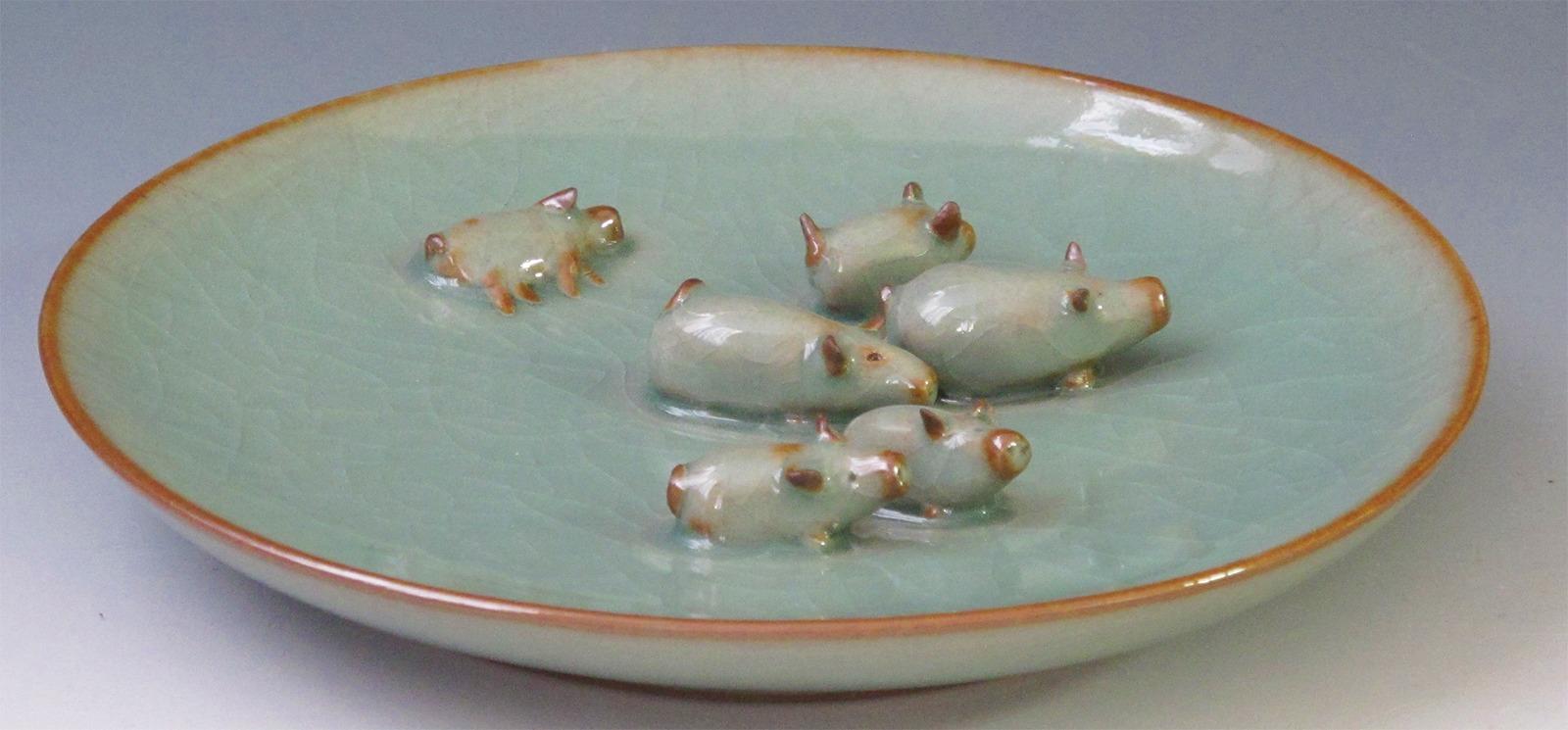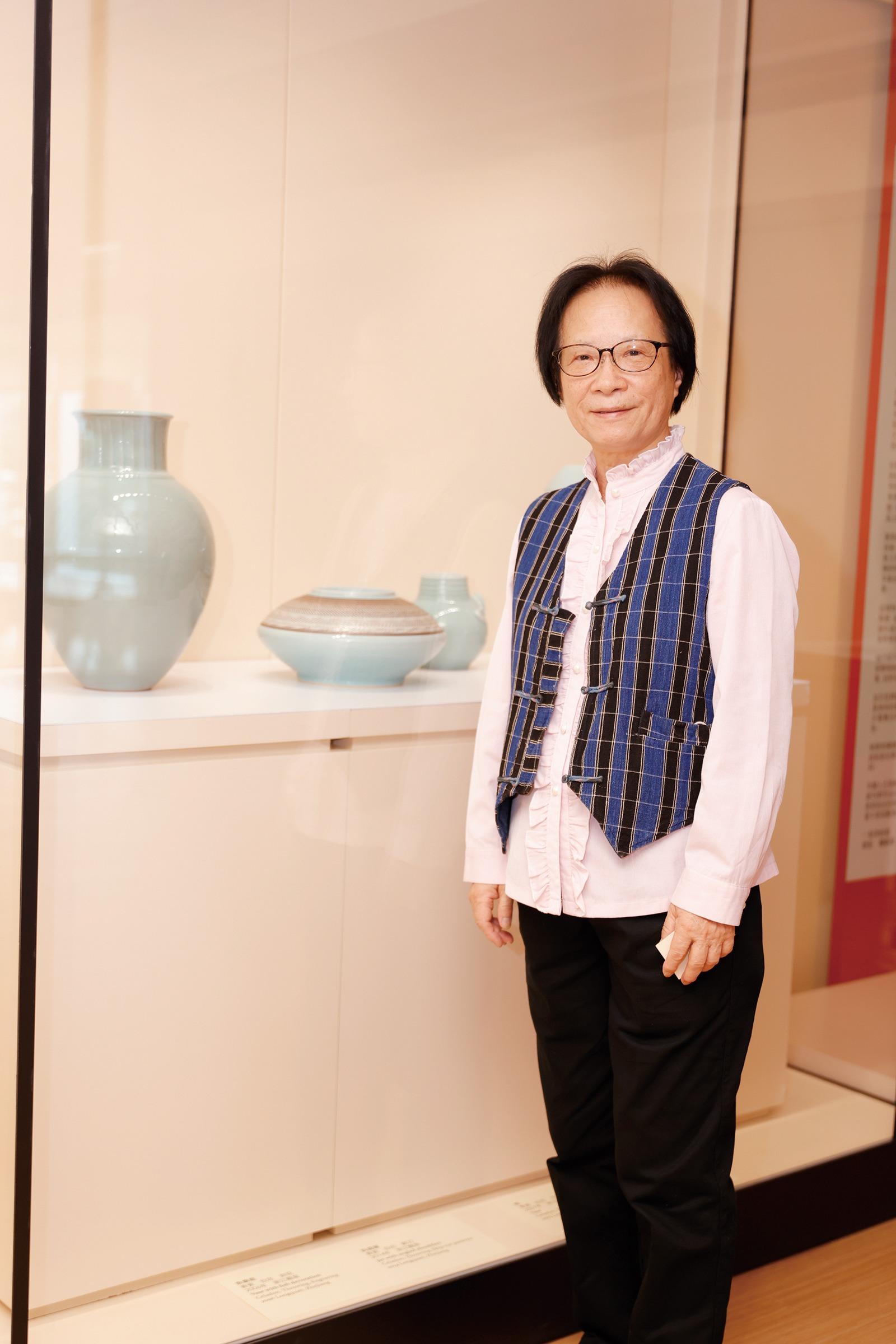 Joyful, a celadon dish sculpture by Wong, was inspired by a bunch of pigs frolicking on a river bank in Longquan. GBA briefs
(PHOTO PROVIDED TO CHINA DAILY)
Joyful, a celadon dish sculpture by Wong, was inspired by a bunch of pigs frolicking on a river bank in Longquan. GBA briefs
(PHOTO PROVIDED TO CHINA DAILY)
At first glance, it looks like a family of pigs crossing a watery expanse. Wong May-lee, who sculpted the dish-shaped celadon piece, however, is quick to point out that the minuscule figurines in it are, in fact, modeled on a herd she had once watched “taking a leisurely stroll” along a river bank.
Called Joyful, the piece was crafted in 2001. It was fired at a kiln in Longquan, a county-level city in East China’s Zhejiang province. Longquan is the home of celadon — the luminous emerald-hued pottery that results from applying the earliest glazing technique (c 950) found in Chinese ceramic history.
“The thicker glaze in the middle of the plate creates the impression that the pigs are frolicking in the river,” Wong explains. The piece connects memories of her time doing labor-intensive work at a kiln with that of sighting the flock, and the feeling of pure delight experienced as a result.
Wong has been back to Longquan several times, as part of her project to learn from the master artisans from around the world. Her quest has taken her to the UK, Taiwan, Japan and Australia.
Active in the field since the 1970s, Wong is one of Hong Kong’s ceramic art pioneers, with a long and illustrious career as a teacher of the craft. She has sought out ancient kilns in different corners of the world, incorporating elements from the techniques and aesthetics of a variety of ceramic traditions into her own practice. “However, her greatest accomplishment lies in her ability to revive ancient Chinese ceramic art,” says Yeung Chun-tong, director of the Sun Museum, currently hosting an exhibition of 85 works by the artist.
Examples of Wong’s homage to Chinese ceramic heritage include a pomegranate-red tea set, stool and bowls, pieces that were wood-fired at a Ming Dynasty (1368-1644) kiln in Foshan, Guangdong province. Also featured are vases with black fish motifs vivid against a “pearl” background. Wong made these in Australia, following the technique used to produce the iconic Cizhou ware that flourished in China from the Song Dynasty (960-1279) to the early Yuan Dynasty (1271-1368).
 Hong Kong ceramist Wong May-lee continues to play a role in reviving Chinese ceramic traditions. (PHOTO PROVIDED TO CHINA DAILY)
Hong Kong ceramist Wong May-lee continues to play a role in reviving Chinese ceramic traditions. (PHOTO PROVIDED TO CHINA DAILY)
Archaeological finds such as fragments of celadon basins dated c 960-1368, excavated from the Dayao kiln in Longquan, are displayed alongside celadon works by Wong made as recently as 2021. Yeung says that the pieces crafted by Wong, while embodying “the ancient elegance of Longquan celadon”, are more representational compared with “the realistic depictions found in ancient pottery”, especially when it comes to the images engraved on them.
“For example, the engravings on the celadon plate, River, have a modern aesthetic. The texture on the Jar with Angled Shoulders is achieved using the modern chattering technique”, Yeung adds, referring to making a chiseling tool skip rhythmically over the surface to create an intense pattern.
The artist’s personal favorite is a tea set she made while doing an artist’s residency in Adelaide. “I chose to paint Chinese landscapes on the pots, drawing inspiration from traditional Chinese ink painting. The glaze I used was manufactured in Italy. In essence, the piece embodies a hybrid, global aesthetic, reflecting the diverse influences and experiences that surrounded me at the time,” Wong says.
There are a few quirky pieces in the mix. A lopsided water vessel from 1988, for instance, and an asymmetric vase with a dented surface and imbued with an almost-human personality — going by the way it seems to be cocking its head — from 2010. By comparison, more recent works by the artist seem less adventurous, and, perhaps, more utilitarian. The celadon tea ware with lotus pattern crafted in 2021 is an example.
Wong says she is trying to adapt to Hong Kong’s space crunch, which extends to the arena of art galleries. This time she chose “to display my functional ware rather than large-scale installations” on account of the limitations of the exhibition space.
“The changes in my style reflect the impact of different cultural influences as well as practical considerations about the spaces in which my art is displayed,” Wong adds. “It is through this dynamic interplay between personal expression and external factors that my artistic style has evolved over time.”
If you go
Color by Wong May Lee
Date: Through Oct 7
Venue: Sun Museum, SML Tower, 165 Hoi Bun Road, Kwun Tong


